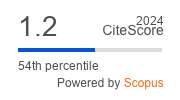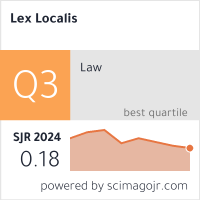Prilagodljiva javna uprava. Vodstveni in ocenjevalni instrumenti
DOI:
https://doi.org/10.4335/15.4.763-784(2017)Ključne besede:
prilagoditev, prilagodljivo javno vodenje, zmožnost prilagajanja, prilagodljiva javna upravaPovzetek
Prilagodljiva javna uprava je pogosto predmet teoretičnih in empiričnih analiz. Pojem sam po sebi predstavlja dokončnost več pristopov, ki ocenjujejo in operacionalizirajo vpliv sprememb, ki jih sproži notranje in zunanje okolje, na trenutni status javne ali zasebne organizacije. Namen pričujočega prispevka je podati prvo celostno sintezo teh procesov oziroma najsodobnejše tehnologije z namenom podajanja kompleksnega okvirja in vizije razvoja temeljitejših prihodnjih analiz. Naš pristop podpira izvajanje zavestne in potrjene vizije o prilagoditvi v javnih organizacijah in/ali javni upravi in razkriva njihove posebnosti, potrebo po izboljšanju vodstvenih in ocenjevalnih instrumentov ter multidisciplinarno vrednotenje različnih vidikov organizacijske prilagoditve.
Literatura
Bartoli, A. (1997) Le management dans les organizations publiques (Paris: Ed. Dunod).
Bentley, T. & Wilsdon, J. (2003) Introduction: the adaptive state, In: Bentley, T. & Wilsdon, J. (eds.) The Adaptive State: Strategies for personalising the public realm (London: Demos), pp. 11-36.
Canter, L. & Atkinson, S. F. (2010) Adaptive management with integrated decision making: an emerging tool for cumulative effects management, Impact Assessment and Project Appraisal, 28(4), pp. 287-297, http://dx.doi.org/10.3152/146155110X12838715793002.
Cayer, N. J., Baker, D. L. & Weschler, L. F. (2010) Public administration. Social change and adaptive management, Third Edition (San Diego: Brikdalee Publisher).
Chase-Dunn, C. & Babones, S. J. (2006) Introduction, In: Chase-Dunn, C. & Babones, S. J. (eds.) Global Social Change. Historical and Comparative Perspectives (Baltimore: Johns Hopkins University Press), pp. 1-7.
Connolly, P. (2007) Deeper Capacity Building for Greater Impact. Designing a Long-term Initiative to Strengthen a Set of Nonprofit Organizations (New York: James Irvine Foundation).
Craig, R. K. & Ruhl, J. B. (2014) Designing Administrative Law for Adaptive Management, Vanderbilt law review, G7(1), pp. 1-87.
Damanpour, F. & Gopalakrishnan, S. (1999) Organizational adaptation and innovation: the dynamics of adopting innovation types, In: Brockhoff, K., Chakrabarti, A. & Hauschildt, J. (eds.) The Dynamics of Innovation. Strategies and Managerial Implications (Berlin: Springer-Verlag Berlin Heidelberg), pp. 53-80.
Doremus, H, Andreen, W. L, Camacho, A. E., Farber, D. A., Glicksman, R. L., Goble, D. D., Karkkainen, B. C., Rohlf, D, Tarlock, A. D, Zellmer, S. B, Jones, S. C. & Huang, L. Y. (2011) Making Good Use of Adaptive Management, Center for Progressive Reform White Paper No. 1104 (Washington DC: Center for Progressive Reform).
Ferlie, E., Lynn, L. & Pollitt, Ch. (2005) The Oxford Handbook of Public Management (Oxford: Oxford University Press).
Halbert, C. (1993) How adaptive is adaptive management? Implementing adaptive management in Washington State and British Columbia, Reviews in Fisheries Science 1(3), pp. 261-283, doi: 10.1080/10641269309388545.
Henry, N. (2001) Public Administration and Public Affairs, Eighth Editions (New Jersey: Prentice Hall).
Hoffman, O. (2004) Sociologia organizațiilor (București: Editura Economică).
Holling, C.S. (1978) Adaptive environmental assessment and management (New York: John Wiley & Sons).
Lewin, R. (1993) Complexity – Life at the Edge of Chaos (London: J. M. Dent).
Lynn, L.E., Jr. (1996) Public Management: Art, Science, or Profession (Washington, DC: CQ Press).
Lynn, L. E., Jr. (2003) Public management, In: Peters, B.G. & Pierre, J. (eds.) Handbook of Public Administration (London: Sage), pp. 14-24.
Matei, A. (2003) Analiza sistemelor administrației publice (București, Editura Economică).
Matei, A. & Matei, L. (2012) Administrative convergence in some Balkan states. A socio-empirical study, Procedia Social and Behavioral Sciences, 62, pp. 1061-1065, https://doi.org/10.1016/j.sbspro.2012.09.181.
Matei, A., Matei, L. & Săvulescu, C. (2013) Digital Ecosystems for Public Affairs, AWER Procedia Information Technology & Computer Science, 4, pp. 724-733.
Matei, A., Popa, F.M. & Săvulescu, C. (2011) Internalisation of the Values of National Integrity Systems and Governance Performance in Some South-Eastern European States: Significant Aspects and Comparative Studies, Proceedings of the 7th European Conference on Management, Leadership and Governance, Sophia-Antipolis, France, pp. 285-295.
Matei, L. (2001) Management public, Second edition (București, Editura Economică).
Matei, L. & Matei, A. (2009) Corruption in the public organizations. Towards a model of cost-benefit analysis for the anticorruption strategies, Transylvanian Review of Administrative Sciences, 27E, pp. 145-171.
Milakovich, M. E. & Gordon, G. J. (2009) Public Administration in America, Tenth Edition (SUA: Wadsworth Cengage Learning).
Mitchell, F. & Mitchell, Ch. (2015) Adaptive Administration: Public Administration and Constant Change, PATimes, USA: ASPA.
Mitchell, F. & Mitchell, Ch. (2016) Adaptive administration: Practice Strategies for Dealing with Constant Change in Public Administration and Policy, ASPA Series in Public Administration and Public Policy (Boca Raton: CRC Press, Taylor & Francis Group).
Piaget, J. (1936) Origins of intelligence in the child (London: Routledge & Kegan Paul).
Pollitt, C. & Bouckaert, G. (2000) Public Management Reform: A comparative Analysis (Oxford: Oxford University Press).
Quirk, B. (2003) Local government: the adaptive tier of governance, In: Bentley, T. & Wilsdon, J. (eds.) The Adaptive State: Strategies for personalising the public realm (London: Demos), pp. 99-111.
Reever Morghan, K., Sheley, R. & Svejcar, T. (2006) Successful Adaptive Management—The Integration of Research and Management, Rangeland Ecology & Management: March, 59(2), pp. 216-219.
Scarlat, E. & Chiriță, N. (2012) Bazele ciberneticii economice (in Romanian) (București, Editura Economică).
Scarlett, L. (2013) Collaborative adaptive management: challenges and opportunities, Ecology and Society, 18(3), 26, http://dx.doi.org/10.5751/ES-05762-180326.
Shafritz, J. & Russell, E. (2005) Introducing Public Administration, 3th edition (London: Pearson Longman).
Sorgenfrei, M. & Wrigley, R. (2005) Renforcement des capacitiés d'analyse et d'adaptation pour une meilleure efficacité organisationnelle, Praxis Paper, no. 7 (Oxford: INTRAC).
Stankey, G.H. (2003) Adaptive management at the regional scale: breakthrough innovation or mission impossible? A report or an American experience, In: Wilson, B. P. & Curtis, A. (eds.) Proceedings of the 2002 Fennor Conference on the Environment Agriculture for the Anstraban Environment (Canberra: Anstraban), pp. 159-177.
Strichman, N. & Marshood, F. (2010) Adaptive Capacity and Social Change. Introduction: A conceptual Framework, New England Journal of Public Policy, 23(1), Article 19.
Sussman, C. (2003) Building Adaptive Capacity: The Quest for Improved Organizational Performance. Management Consulting Services (Boston: Sussman Associates).
Titi, V. & Singh, N. (1994) Adaptive strategies of the poor in arid and semi-arid lands: In search of sustainable livelihoods, IISD working paper (Winnipeg: IISD).
Valman, M., Österblam, H. & Olsson, P. (2015) Adaptive governance of the Baltic Sea – lessons from elsewhere, International Journal of the Commons, 9(1), pp. 440–465.
Walters, C. J. (1989) An experimental strategy for ground fish management in the face of large uncertainty about stock size and production, Canadian Special Publication of Fisheries and Aquatic Sciences, 108, pp. 13-25.








